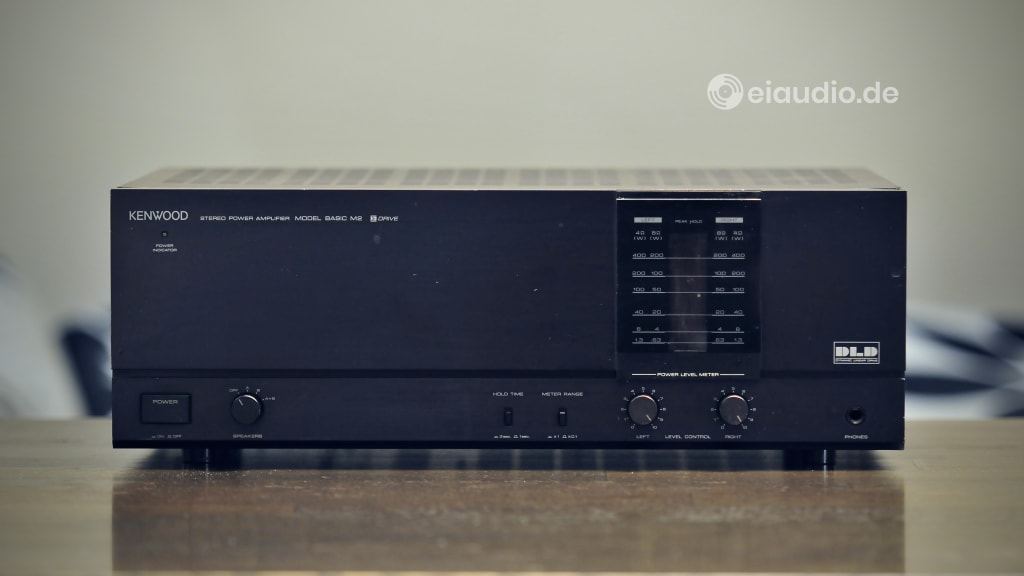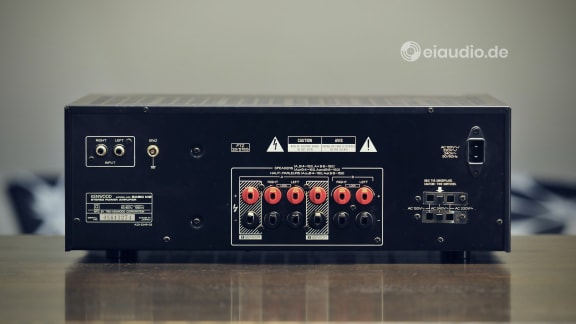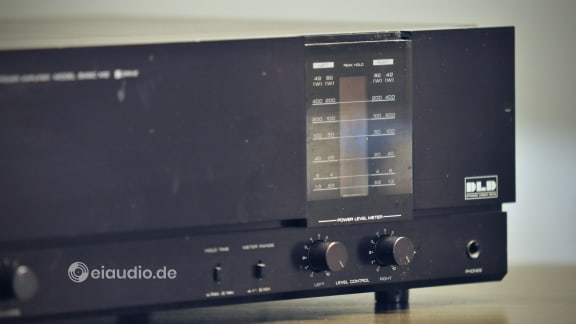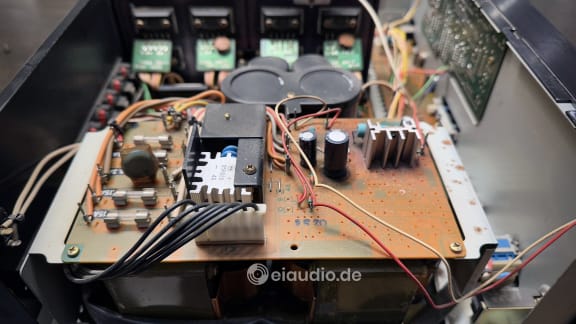Kenwood Basic M2 Sigma Drive
Published: 14/01/2023
Manufacturing date: 1983
Author: Karsten Hein
Category: Gear & Review
Tag(s): Power Amplifiers
Having previously reviewed the Kenwood KR-9400 receiver of the mid 1970s, with its posh-looking brushed aluminum face plate, solid aluminium buttons and switches, all housed in an assembled metal frame that had originally been flanked by wooden sides, the black box design of the Kenwood Basic M2 with its thin, bent metal enclosure of the mid 1980s, was a bit of a let-down. The M2 shared this aesthetically reduced, light-weight design with most of the competing products of its time. Where, just ten years earlier, innovation had been in the machining and assembly of parts, this next phase was mostly about experimenting with the electronics inside to eliminate the shortcomings of the earlier circuit designs.
The 1980s were also a time of increased price competition. With more companies entering the market in the lower and mid-price segment with gear that fulfilled the basic demand of the average consumer, material and shipping costs needed to also come down on some of the established brands in the market. Kenwood was such an established brand, and the M2 Basic chassis offered 100 watts per channel more than the KR-9400 receiver and, proving the point, weighed five kilos less. Five kilos of net savings in materials and shipping weight would have made a considerable difference in the cost planning of a company that could sell thousands if not millions of iterations of each product.
In terms of assessing vintage equipment, the modern mass-market approach often lead to the immediate depreciation of value once the manufacturer’s warranty period had expired. However, this did not necessarily mean that the sound quality itself was compromised or that the inner circuitry similarly reflected the mass-market approach of the chassis. In fact, the 1980s were still a time of HiFi innovation, and the M2’s Sigma Drive introduced an all-new solution to the age-old challenge of handling the dynamic back current running from the loudspeaker to the amplifier. Instead of simply offering ultra-low internal resistance and measuring signal damping at 1,000 Hz, the Sigma Drive took into account the real feedback of the loudspeakers, regardless of the frequency.
In the tradition of decent High End power amplifiers, the Basic M2 used a separate power supply for each stereo channel. This was to lower the noise floor by eliminating cross-talk between the channels. The two heavy transformers were placed to the left side of the amp, thus leading to an uneven distribution of weight within the unit. The main board holding the two large capacitors per channel was located in the centre of the unit, culminating in the power transistor section with one large heat sink and a large cooling fan to the right. In domestic operation, the cooling fan would not play much of a role, but for owners willing to drive their M2 at full capacity, the fan would provide a safety net for the survival of the transistors.
The Basic M2 employed two pairs of transistor ICs: one set of DAT1521P / DAT1521N and one set of DAT1018P / DAT1018N, all of them fast switching 5-pin power MOSFETs made by Sanken. Especially the DAT1018P/N variety saw repeated supply shortages in recent years which would have made repairs of the amplifier section more difficult. The choice of fast switching ICs would have provided the Basic M2 with greater resistance to high frequency feedback which would otherwise have exceeded the slew rate of the amplifier. The new Sigma Drive circuitry would have similarly benefitted from the choice of ICs.
The Sigma Drive was designed to integrate the physical behaviour of a dynamic driver and the resulting dynamically unpredictable back current within the circuitry of the amplifier by monitoring the resulting deviation right at the speaker terminal and converting it into a mere current variation. As amplifier output constituted a voltage surplus, the ability to maintain voltage deviation at zero, by means of adaptive damping, led to exceptionally low harmonic distortion of just 0.004% measured across all frequencies. Effective back current damping was rated at above 1000:1 beyond the audible spectrum. With the new Sigma Drive feature on board, Kenwood introduced a new dimension in noise control that had the audio press of the 1980s interested for some time.
Kenwood was not the only HiFi manufacturer attempting to improve back current handling. Yamaha introduced “RO Control” on their B-4 and A-9 amplifiers, Aurex called their version “Clean Drive”, and Fidelix referred to their concept as “Remote Sensing NFB”. However, none of these technologies went as far as that of Kenwood which included measuring the whole loudspeaker from the voice coils to the speaker cable. This would have given Kenwood the upper hand in achieving the most accurate readings, if it had not been for a few issues that involved the use of two strands of speaker wires which needed to be connected in a fashion that was somewhat counter intuitive.
For the Sigma Drive circuitry to work its magic, two sets of wires needed to be connected between the amplifier and each speaker. Next to the common red and black binding posts per channel, there were two additional binding posts on the amplifier that were labelled as Sigma Sensor. Therefore the second set of wires ran from the Sensor posts, quite counter-intuitively, to the same binding posts on the speakers. This feature was only available for the speakers A and not for the speakers B. This meant that owners of the amplifier had to study their operating manuals carefully in order not to misconnect and destroy their amp. When connecting the amp for the first time, I therefore asked my wife to look over my shoulder and assure that all instructions in the manual were followed.
When connected correctly, the rather power-hungry Basic M2 offered a spacious and clean sound that was tonally rich and slightly dark in true Kenwood fashion. Hooked up between our Dynaco PAS-4 preamplifier and Martin Logan SL-3 electrostatic speakers, the music sounded soothing and voluptuous rather than exciting or sharp. This was an amplifier for easy entertainment rather than analytical listening. For an amplifier of this size and caliber, I was surprised by the amount of control it held on the flow of the music and on the rhythm. Where the Kenwood receiver sounded overly eager to tell the whole story all at once, the Basic M2 seemed to hold back, occasionally to the point of stomping and drudging. This may have been the effect of transients being cut short, and it sometimes took the fluidity from the music event.
I was generally pleased with the Basic M2’s performance. Connected to a difficult load as the Martin Logan SL-3, the Kenwood could really show its back current handling abilities. In combination with the two sets of OFC multi-strand speaker cables that I had available to test the Sigma Drive, I would hesitate to brand it audiophile material. However, it was well possible that a different combination of wires and preamplifier would have led to a more revealing result. Tonally rich and dark, the Kenwood followed the preferred sound signature of American customers of the time and thus offered a welcome contrast to the established European brands.
Specifications
- Type: Stereo Power Amplifier
- Special features: High-damping, Sigma Drive
- Power output (8 Ohms): 2x 220 WPC
- Power output (4 Ohms): 2x 324 WPC
- Frequency response: 1Hz to 200kHz (-3 dB)
- Total harmonic distortion: < 0.004%
- Dynamic headroom: 1.5 dB (8 Ohms)
- Damping factor: 1000:1
- Transistor-ICs: Sanken DAT1521P/N, DAT1018P/N
- Transistor type: Power MOSFET (5-pin)
- Rise time: 1.8 uS
- Slew Rate: 100 V / uS
- Input sensitivity: 1.0 V / 47 kOhms
- Signal to noise ratio: > 120dB
- Speaker load impedance: 4 to 16 Ohms
- Power consumption (max.): 1.350 watts
- Dimensions: (W) 440mm x (H) 158mm x (D) 373mm
- Weight: 15.5 kg
- Country of manufacture: Japan
- Year(s): 1983-1985






